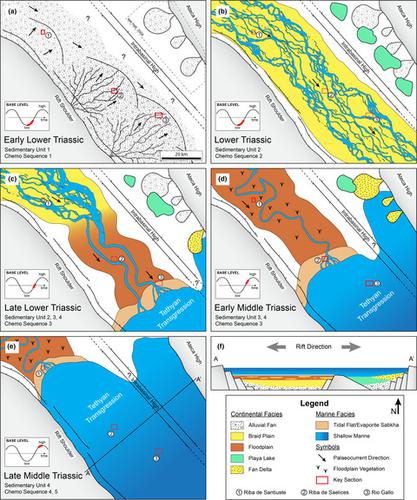当前位置:
X-MOL 学术
›
Basin Res.
›
论文详情
Our official English website, www.x-mol.net, welcomes your feedback! (Note: you will need to create a separate account there.)
Basin-scale fluvial correlation and response to the Tethyan marine transgression: an example from the Triassic of central Spain
Basin Research ( IF 3.2 ) Pub Date : 2020-04-27 , DOI: 10.1111/bre.12451 Maximilian Franzel 1 , Stuart J. Jones 1 , Neil Meadows 2 , Mark B. Allen 1 , Ken McCaffrey 1 , Tim Morgan 3
Basin Research ( IF 3.2 ) Pub Date : 2020-04-27 , DOI: 10.1111/bre.12451 Maximilian Franzel 1 , Stuart J. Jones 1 , Neil Meadows 2 , Mark B. Allen 1 , Ken McCaffrey 1 , Tim Morgan 3
Affiliation

|
The relationships between large‐scale depositional processes and the stratigraphic record of alluvial systems, e.g. the origin and distribution of channel stacking patterns, changing architecture and correlation of strata, are still relatively poorly understood, in contrast to marine systems. We present a study of the Castillian Branch of the Permo‐Triassic Central Iberian Basin, north‐eastern Spain, using chemostratigraphy and a detailed sedimentological analysis to correlate the syn‐rift Triassic fluvial sandstones for ~80 km along the south‐eastern basin margin. This study investigates the effects of Middle Triassic (Ladinian) Tethyan marine transgression on fluvial facies and architecture. Chemostratigraphy identifies a major, single axially flowing fluvial system lasting from the Early to Middle Triassic (~10 Ma). The fluvial architecture comprises basal conglomerates, followed by amalgamated sandstones and topped by floodplain‐isolated single‐ or multi‐storey amalgamated sandstone complexes with a total thickness up to ~1 km. The Tethyan marine transgression advanced into the basin with a rate of 0.04‐0.02 m yr‐1, and is recorded by a transition from the fluvial succession to a series of maximum flooding surfaces characterised by marginal marine clastic sediments and sabkha evaporites. The continued, transgression led to widespread thick carbonate deposition infilling the basin and recording the final stage of syn‐rift to early‐post rift deposition. We identify the non‐marine to marine transition characterised by significant changes in the Buntsandstein succession with a transition from a predominantly tectonic‐ to a climatically‐driven fluvial system. The results have important implications for the temporal and spatial prediction of fluvial architecture and their transition during a marine transgression.
中文翻译:

盆地尺度河流相关性和对特提斯海侵的响应:以西班牙中部三叠纪为例
与海洋系统相比,大规模沉积过程与冲积系统的地层记录之间的关系,例如河道堆积模式的起源和分布、不断变化的结构和地层的相关性,仍然相对较少了解。我们介绍了西班牙东北部二叠纪-三叠纪伊比利亚中部盆地卡斯蒂利亚支脉的研究,使用化学地层学和详细的沉积学分析,将沿盆地东南缘约 80 公里的同裂谷三叠纪河流砂岩关联起来。本研究调查了中三叠世(拉丁阶)特提斯海侵对河流相和建筑的影响。化学地层学确定了一个主要的、单一的轴向流动河流系统,持续时间从早三叠世到中三叠世(~10 Ma)。河流结构包括基底砾岩,其次是混合砂岩,顶部是漫滩隔离的单层或多层混合砂岩复合体,总厚度可达约 1 公里。特提斯海侵以 0.04-0.02 m yr-1 的速度推进到盆地中,记录为从河流序列过渡到一系列以边缘海相碎屑沉积物和 sabkha 蒸发岩为特征的最大洪水面。持续的海侵导致广泛的厚碳酸盐沉积充填盆地,并记录了同裂谷沉积到早期裂谷后沉积的最后阶段。我们确定了非海洋到海洋的转变,其特征是 Buntsandstein 序列发生了显着变化,从主要是构造作用到气候驱动的河流系统的转变。
更新日期:2020-04-27
中文翻译:

盆地尺度河流相关性和对特提斯海侵的响应:以西班牙中部三叠纪为例
与海洋系统相比,大规模沉积过程与冲积系统的地层记录之间的关系,例如河道堆积模式的起源和分布、不断变化的结构和地层的相关性,仍然相对较少了解。我们介绍了西班牙东北部二叠纪-三叠纪伊比利亚中部盆地卡斯蒂利亚支脉的研究,使用化学地层学和详细的沉积学分析,将沿盆地东南缘约 80 公里的同裂谷三叠纪河流砂岩关联起来。本研究调查了中三叠世(拉丁阶)特提斯海侵对河流相和建筑的影响。化学地层学确定了一个主要的、单一的轴向流动河流系统,持续时间从早三叠世到中三叠世(~10 Ma)。河流结构包括基底砾岩,其次是混合砂岩,顶部是漫滩隔离的单层或多层混合砂岩复合体,总厚度可达约 1 公里。特提斯海侵以 0.04-0.02 m yr-1 的速度推进到盆地中,记录为从河流序列过渡到一系列以边缘海相碎屑沉积物和 sabkha 蒸发岩为特征的最大洪水面。持续的海侵导致广泛的厚碳酸盐沉积充填盆地,并记录了同裂谷沉积到早期裂谷后沉积的最后阶段。我们确定了非海洋到海洋的转变,其特征是 Buntsandstein 序列发生了显着变化,从主要是构造作用到气候驱动的河流系统的转变。



























 京公网安备 11010802027423号
京公网安备 11010802027423号